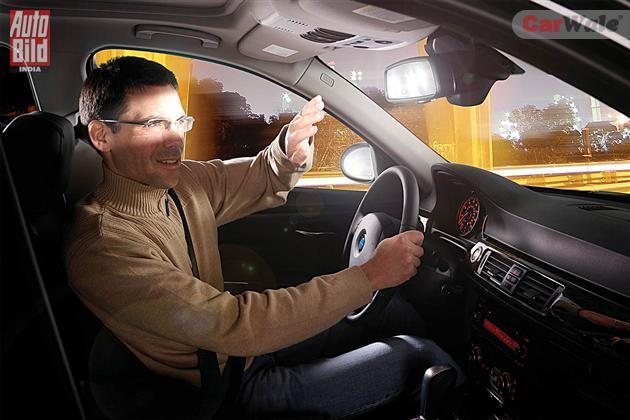 It’s just another day of the week and as you’re driving home a car on the other side whizzes by. The glare from its headlamps catches you for just a brief few seconds but leaves you completely, scarily blind for the next minute. What you’ve experienced is a condition called night blindness, one that could lead you straight to the jaws of death.
It’s just another day of the week and as you’re driving home a car on the other side whizzes by. The glare from its headlamps catches you for just a brief few seconds but leaves you completely, scarily blind for the next minute. What you’ve experienced is a condition called night blindness, one that could lead you straight to the jaws of death.
The affliction happens when bright light falls very briefly on your eyes (already tuned to a low light condition). The pupils contract quickly to adjust to the bright light but can’t re-dilate quickly enough. The result? You turn temporarily blind! Although it’s a temporary condition, it can be fatal if you’re driving, due to its ability to lead you into a collision.
With the scary part out of the way, the good news is that there are ways and means to reduce the effects of such night blindness. And of course, your magazine AUTO BILD INDIA is the only one to tell you what they are.
1. Thin side frames for spectacles
If the driver must wear spectacles to drive, frames that have thin sidepieces should be selected, as wider side pieces will anyway cause obstruction to his peripheral vision. Speaking of which, drivers should get an eye examination done to check if their peripheral vision is fine.
2. Drive within the range of headlights
Drive within the range of your headlights, not by what you think you see beyond your headlights. At night, headlights limit our visual range to the area they illuminate – 60 to 90m ahead. At a modest 60kmph a car will cover around 90m in just four seconds! Therefore, slower driving speeds will allow you more time to spot a hazard and respond in a crisis.
3. Slower lanes are safer
It’s advisable to drive in the slow lane as the light from oncoming traffic will not blind you. Being in the fast lane puts you directly in the path of light from oncoming traffic, thus compounding your problem. So move to slower lanes. Also, on Indian highways, there are numerous human settlements with no options for a foot bridge or pedestrian crossing. So people just run across the highway without any warning. Traveling in the middle lane allows room for you to manoeuvre so that you can avoid hitting them.
4. Clean windscreen means better vision
It isn’t just dirt and grime on the outside of the windscreen that will reduce night vision. Even streaks on the inside or fingerprints will scatter light and reduce visibility. Clean the windscreen properly, inside out.
5.Level the Headlights
The headlamp leveling button, with which one can increase or decrease the headlamps’ reach, is available on all cars. In some cars the instrument cluster lighting can also be altered, which is helpful as bright lighting can distract the driver at night.
6. Older people require more light
In addition to the problems listed above there is the fact that as we age, the lenses of our eyes become yellowed and we need more light to see. Most of us begin to notice this as we approach the age of 40. By the time we reach the age of 65 we need 2.5 times the amount of light that we needed when we were 20 to see the same level of detail.
For this very reason, older persons should drive slower when they find it necessary to drive at night.
Bad diets and too much alcohol consumption can also lead to premature yellowness of eyes with even young adults.
7. Reduce the glare on your rearview
Even headlights falling on the rearview mirror can be reason for temporary blindness. Before you start driving at night, adjust your rear view mirror to the “night” setting to dim the headlight glare coming from behind. Most cars built now-a-days come with this feature, so use it at night. As shown in the two images below, the headlights falling on the rear view mirror can not only be distracting to most people, but for people suffering from night blindness, it can easily lead to a temporary condition where one can’t see at all.
8. Dietary considerations
If you have weak eyes or suffer from night vision problems then consuming green vegetables such as spinach and collards, which are high in lutein and zeaxanthin, two nutrients vital for healthy eyes. To alleviate eye problems try and avoid smoking, drinking too much, though a glass of red wine daily is fine. Too much hydrogenated oils and excessive intake of refined carbohydrates and sugar are also a complete no-no. Vitamin A deficiency can easily be remedied by including fish oils, liver, dairy products in your regular diet.
9. Avoid driving at night, take a cab
If you are aware of your night blindness then it’s best to leave the driving till the next morning. Avoid driving at night and drive only during the day. Take a cab or try to get people to drive you around at night as even good lighting conditions at night, such as found in a big city, can be troublesome to someone with night blindness.
10.Don’t stare into the glare
When encountering glare from oncoming traffic, if a driver turns his or her head from side to side, it will help make up for the lost side vision that occurs at night. Also, not looking directly at the light source helps, provided you keep your sight on other objects on the road. Look at the edge of your side of the road to avoid being blinded.
Source: Carwale via Autobild india
